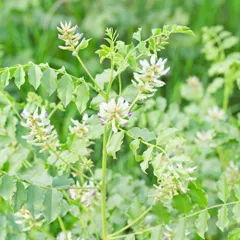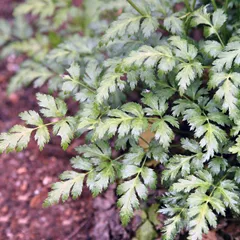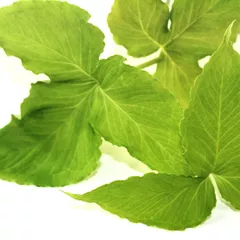Pi Pa Qing Fei Yin
Chinese: 枇杷清肺饮
Pinyin: Pí Pá Qīng Fèi Yǐn
Other names: Eriobotrya Decoction to Clear the Lung, Loquat Decoction to Clear the Lung, Decoction of Folium Eriobotrya for Removing Heat from the Lung




Pi Pa Qing Fei Yin
Chinese: 枇杷清肺饮
Pinyin: Pí Pá Qīng Fèi Yǐn
Other names: Eriobotrya Decoction to Clear the Lung, Loquat Decoction to Clear the Lung, Decoction of Folium Eriobotrya for Removing Heat from the Lung
Ingredients: 6 herbs
Category: Formulas that clear Lung-Heat
- Clears Lung Heat
- Cools the Blood
- Clears Dampness
- Invigorates the Blood
Source: Wai Ke Da Chen (外科大成) (1665 AD )
The information provided here is not a replacement for a doctor. You shouldn't use it for the purpose of self-diagnosing or self-medicating but rather so you can have a more informed discussion with a professional TCM practitioner.
Pi Pa Qing Fei Yin is a 6-ingredient Chinese Medicine formula with Loquat Leaves (Pi Pa Ye) as a principal ingredient.
Invented in 1665 AD, it belongs to the category of formulas that clear Lung-Heat. Its main actions are: 1) clears Lung Heat and 2) cools the Blood .
In Chinese Medicine health conditions are thought to arise due to "disharmonies" in the body as a system. These disharmonies are called "patterns" and the very purpose of herbal formulas is to fight them in order to restore the body's harmony.
In this case Pi Pa Qing Fei Yin is used by TCM practitioners to fight patterns like Lung Heat or Phlegm-Heat in the Lungs. From a Western Medicine standpoint, such patterns can give rise to a range of conditions such as acne, facial acne or red nose for instance.
On this page, after a detailed description of each of the six ingredients in Pi Pa Qing Fei Yin, we review the patterns and conditions that Pi Pa Qing Fei Yin helps treat.
The six ingredients in Pi Pa Qing Fei Yin

Pi Pa Ye is a king ingredient in Pi Pa Qing Fei Yin. Like the name indicates, it means it has more power than other ingredients in the formula.
1. Loquat Leaves (Pi Pa Ye)
Part used: Dried leaves
Nature: Cool
Taste(s): Bitter
Meridian affinity: StomachLung
Category: Herbs that relieve coughing and wheezing
Pi Pa Ye transforms Phlegm, clears Lung Heat and descends Lung Qi. Together with Mulberry bark, Goldthread rhizomes , it treats cough with copious yellow Phlegm due to Lung Heat.

Sang Bai Pi is a deputy ingredient in Pi Pa Qing Fei Yin. This means it helps the king ingredient(s) treat the main pattern or it serves to treat a coexisting pattern.
2. Mulberry Bark (Sang Bai Pi)
Part used: Dried root bark
Nature: Cold
Taste(s): Sweet
Meridian affinity: Lung
Category: Herbs that cool the Blood
In general Sang Bai Pi's main actions are as follows: "Clears heat from the lung, relieves asthma and induce urination to disperse swelling"
In the context of Pi Pa Qing Fei Yin, it is used because it drains Heat from the Lungs, stops coughing and wheezing.

Huang Lian is a deputy ingredient in Pi Pa Qing Fei Yin. This means it helps the king ingredient(s) treat the main pattern or it serves to treat a coexisting pattern.
3. Goldthread Rhizomes (Huang Lian)
Part used: Dried rhizome
Nature: Cold
Taste(s): Bitter
Meridian affinity: GallbladderHeartLarge intestineLiverSpleenStomach
Category: Herbs that clear Heat and dry Dampness
In general Huang Lian's main actions are as follows: "Expels Damp-Heat especially in the Lower Burner. Eliminates Fire toxicity especially when there is associated Dampness. Acts as a sedative by eliminating Heart Fire. Eliminates Stomach Fire. Expel parasites"
In the context of Pi Pa Qing Fei Yin, it is used because it clears Heat, drains Dampness and Fire, resolves Tosix-Heat and stops bleeding.

Huang Bo is a deputy ingredient in Pi Pa Qing Fei Yin. This means it helps the king ingredient(s) treat the main pattern or it serves to treat a coexisting pattern.
4. Phellodendron Bark (Huang Bo)
Part used: Dried bark
Nature: Cold
Taste(s): Bitter
Meridian affinity: BladderKidneyLarge intestine
Category: Herbs that clear Heat and dry Dampness
In general Huang Bo's main actions are as follows: "Expels Damp-Heat in the Lower Burner. Clears Kidney Yin Deficient Heat. Applied externally or toxic Fire, especially associated with Dampness."
In the context of Pi Pa Qing Fei Yin, it is used because it drains Damp-Heat, particularly from the Lower Burner. It also clears Toxic-Heat.

Ren Shen is an assistant ingredient in Pi Pa Qing Fei Yin. This means that it either serves to reinforces the effect of other ingredients or it moderates their toxicity.
5. Ginseng (Ren Shen)
Part used: Dried root
Nature: Warm
Meridian affinity: HeartLungSpleen
Category: Tonic herbs for Qi Deficiency
In general Ren Shen's main actions are as follows: "Very strongly tonifies the Qi. Tonifies the Lungs and Spleen. Assists the body in the secretion of Fluids and stops thirst. Strengthens the Heart and calms the Shen (mind/spirit)."
In the context of Pi Pa Qing Fei Yin, it is used because it tonifies Qi and generate Body Fluids so as to stop thirst.

Gan Cao is an envoy ingredient in Pi Pa Qing Fei Yin. This means that it directs the formula towards certain area of the body and/or harmonizes the actions of other ingredients.
6. Liquorice (Gan Cao)
Part used: Dried root and rhizome
Nature: Neutral
Taste(s): Sweet
Meridian affinity: HeartLungSpleenStomach
Category: Tonic herbs for Qi Deficiency
Gan Cao harmonizes the effect of other ingredients. It also moistens the Lung, resolves Toxic-Heat and Phlegm, stop coughing.
Conditions and patterns for which Pi Pa Qing Fei Yin may be prescribed
It's important to remember that herbal formulas are meant to treat patterns, not "diseases" as understood in Western Medicine. According to Chinese Medicine patterns, which are disruptions to the body as a system, are the underlying root cause for diseases and conditions.
As such Pi Pa Qing Fei Yin is used by TCM practitioners to treat two different patterns which we describe below.
But before we delve into these patterns here is an overview of the Western conditions they're commonly associated with:
Acne Facial acne Red nose Red papules Acne inflammatory Whiteheads Blackheads Dry nose Dry mouth Burning sensation Constipation Dry stool Rosacea
Again it wouldn't be correct to say "Pi Pa Qing Fei Yin treats acne" for instance. Rather, Pi Pa Qing Fei Yin is used to treat patterns that are sometimes the root cause behind acne.
Now let's look at the two patterns commonly treated with Pi Pa Qing Fei Yin.

The Lungs is a so-called "Zang" Organ. Learn more about the Lungs in Chinese Medicine
Lung Heat
Pulse type(s): Rapid (Shu), Slippery (Hua)
Symptoms: Acne Thirst Sweating High fever Feeling of heat Shortness of breath Cough with thin yellow sputum
Pi Pa Qing Fei Yin is sometimes prescribed by TCM practitioners to treat Lung Heat. This pattern leads to symptoms such as feeling of heat, thirst, high fever and cough with thin yellow sputum. Patients with Lung Heat typically exhibit rapid (Shu) or slippery (Hua) pulses.
Lung Heat can be acute or chronic.
When acute, it is one of the five patterns of the Qi level, the second level of the Four Levels theory. In that case, it is caused by external invasion of the Lungs by Wind-Heat. The patients usually suffer from flaring of nostrils because the Lungs open to the... read more about Lung Heat

The Lungs is a so-called "Zang" Organ. Learn more about the Lungs in Chinese Medicine
Phlegm-Heat in the Lungs
Pulse type(s): Rapid (Shu), Slippery (Hua)
Tongue coating: Sticky coating, Yellow coating
Tongue shape: Swollen
Symptoms: Acne Fever Clump Thirst Asthma Phlegm Anxiety Coughing Wheezing Insomnia Dizziness Chest pain Constipation Chest fullness Feeling of heat Epigastric pain Phlegm in throat Shortness of breath Clumping in the chest Bitter taste in the mouth Epigastric focal distention Focal distention of the chest Stifling sensation in the chest Coughing of copious thick yellow sputum Feeling of heaviness of the head and body
Pi Pa Qing Fei Yin is sometimes prescribed by TCM practitioners to treat Phlegm-Heat in the Lungs. This pattern leads to symptoms such as coughing, shortness of breath, wheezing and stifling sensation in the chest. Patients with Phlegm-Heat in the Lungs typically exhibit rapid (Shu) or slippery (Hua) pulses as well as Red swollen tongue with a sticky yellow coating.
This pattern is similar to Damp-Phlegm in the Lungs, but with additional Heat features, such as feeling of heat, thirst and profuse sticky yellow or green sputum. The typical manifestations of Phlegm are the coughing, short of breath, Phlegm in the throat and chest oppression. The Phlegm can also... read more about Phlegm-Heat in the Lungs
Formulas similar to Pi Pa Qing Fei Yin
Ban Xia Xie Xin Tang is 43% similar to Pi Pa Qing Fei Yin
Huang Lian Tang is 43% similar to Pi Pa Qing Fei Yin
Ren Shen Ge Jie San is 38% similar to Pi Pa Qing Fei Yin
Si Jun Zi Tang is 33% similar to Pi Pa Qing Fei Yin
Liu Jun Zi Tang is 33% similar to Pi Pa Qing Fei Yin
Ju Yuan Jian is 33% similar to Pi Pa Qing Fei Yin












